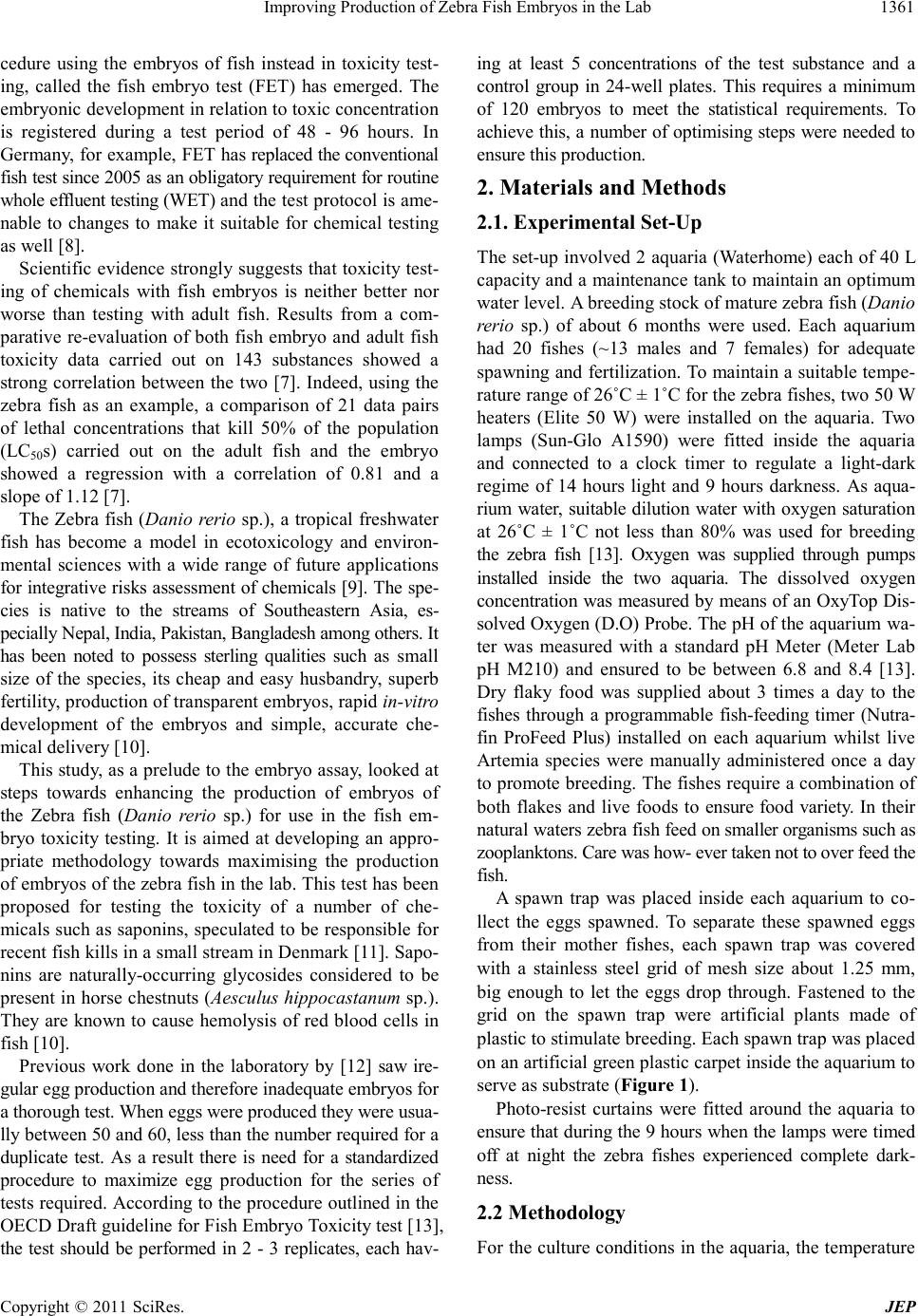
Improving Production of Zebra Fish Embryos in the Lab1361
cedure using the embryos of fish instead in toxicity test-
ing, called the fish embryo test (FET) has emerged. The
embryonic develop ment in rel ation to to xic conce ntratio n
is registered during a test period of 48 - 96 hours. In
Ge r ma ny, fo r e xa mp l e, FE T ha s replaced the conventio nal
fish test since 2005 as an obligatory requirement for routine
whole effluent testing (WET) and the test protocol is ame-
nable to changes to make it suitable for chemical testing
as well [8].
Scientific evidence strongly suggests tha t toxicity test -
ing of chemicals with fish embryos is neither better nor
worse than testing with adult fish. Results from a com-
parative re-evaluation of both fish embryo and adult fish
toxicity data carried out on 143 substances showed a
strong correlation between the two [7]. Indeed, using the
zebra fish as an example, a comparison of 21 data pairs
of lethal concentrations that kill 50% of the population
(LC50s) carried out on the adult fish and the embryo
showed a regression with a correlation of 0.81 and a
slope of 1.12 [7].
The Zebra fish (Danio rerio sp.), a tropical freshwater
fish has become a model in ecotoxicology and environ-
mental sciences with a wide range of future applications
for integrative risks assessment of chemicals [9]. T he spe-
cies is native to the streams of Southeastern Asia, es-
pecially Nepal, India, Pakistan, Bangladesh among others. It
has been noted to possess sterling qualities such as small
size of the species, its cheap and easy husbandry, superb
fertility, pr oductio n of tra nspa rent embr yos, rapid in-vitro
development of the embryos and simple, accurate che-
mical delivery [10].
This study, as a prelude to the embryo assay, looked at
steps towards enhancing the production of embryos of
the Zebra fish (Danio rerio sp.) for use in the fish em-
bryo toxicity testing. It is aimed at developing an appro-
priate methodology towards maximising the production
of embryos of the zebra fish in the lab. This test has been
proposed for testing the toxicity of a number of che-
micals such as saponins, speculated to be responsible for
recent fish kills in a small stream in Denmark [11]. Sapo-
nins are naturally-occurring glycosides considered to be
present in horse chestnuts (Aesculus hippocastanum sp.).
They are known to cause hemolysis of red blood cells in
fish [10].
Previous work done in the laboratory by [12] saw ire-
gular egg production and therefore inadequate embryos for
a thorough test. When eggs were produced they were usua-
lly between 50 and 60, less than the number required for a
duplicate test. As a result there is need for a standardized
procedure to maximize egg production for the series of
tests required. According to the procedure outlined in the
OECD Draft guideline for Fish Embryo Toxicity test [13],
the test should be performed in 2 - 3 replicates, each hav-
ing at least 5 concentrations of the test substance and a
control group in 24-well plates. This requires a minimum
of 120 embryos to meet the statistical requirements. To
achieve this, a number of optimising steps were needed to
ensure this production .
2. Materials and Methods
2.1. Experimental Set-Up
The set-up involved 2 aquaria (Waterhome) each of 40 L
capacity and a maintenance tank to maintain an optimum
water level. A breeding stock of mature zebra fish (Danio
rerio sp.) of about 6 months were used. Each aquarium
had 20 fishes (~13 males and 7 females) for adequate
spawning and fertilization. To maintain a suitable tempe-
rature range of 26˚C ± 1˚C for the zebra fishes, two 50 W
heaters (Elite 50 W) were installed on the aquaria. Two
lamps (Sun-Glo A1590) were fitted inside the aquaria
and connected to a clock timer to regulate a light-dark
regime of 14 hours light and 9 hours darkness. As aqua-
rium water, suitable dilution water with oxygen saturation
at 26˚C ± 1˚C not less than 80% was used for breeding
the zebra fish [13]. Oxygen was supplied through pumps
installed inside the two aquaria. The dissolved oxygen
concentration was measured by means of an OxyTop Dis-
solved Oxygen (D.O) Probe. The pH of the aq uari um wa-
ter was measured with a standard pH Meter (Meter Lab
pH M210) and ensured to be between 6.8 and 8.4 [13].
Dry flaky food was supplied about 3 times a day to the
fishes through a programmable fish-feeding timer (Nutra-
fin ProFeed Plus) installed on each aquarium whilst live
Artemia species were manually administered once a day
to promote breeding. The fishes require a combination of
both flakes and live foods to ensure food variety. In their
natural waters zebra fish feed on smaller organisms such as
zooplanktons. Care was how- ever taken not to over feed the
fish.
A spawn trap was placed inside each aquarium to co-
llect the eggs spawned. To separate these spawned eggs
from their mother fishes, each spawn trap was covered
with a stainless steel grid of mesh size about 1.25 mm,
big enough to let the eggs drop through. Fastened to the
grid on the spawn trap were artificial plants made of
plastic to stimulate breeding. Each spawn trap was placed
on an artificial green plastic carpet inside the aquarium to
serve as substrate (Figure 1).
Photo-resist curtains were fitted around the aquaria to
ensure that during the 9 hour s when the lamps were timed
off at night the zebra fishes experienced complete dark-
ness.
2.2 Methodology
For the culture conditions in the aquaria, the temperature
Copyright © 2011 SciRes. JEP